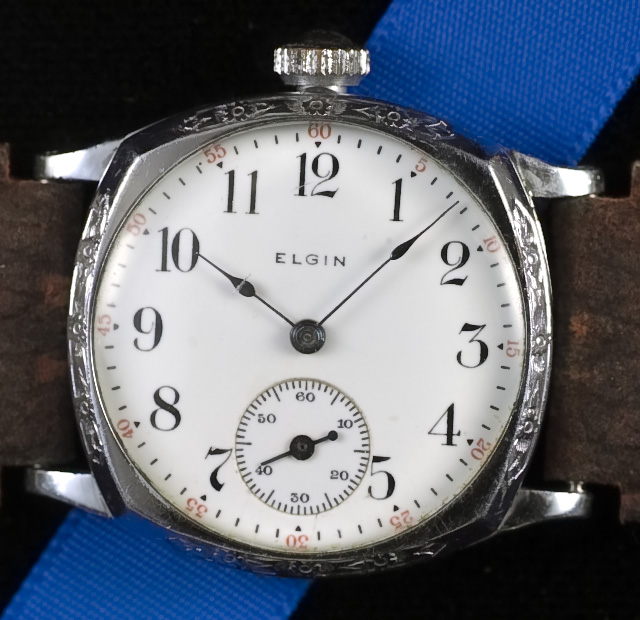Results 1 to 11 of 11
-
23rd December 2016, 09:04 AM #1

- Join Date
- Oct 2013
- Location
- Philippines
- Posts
- 12,181
- Real Name
- Brian
A new learning series: Pocket Watch
-
23rd December 2016, 09:26 AM #2

- Join Date
- Feb 2012
- Location
- Texas
- Posts
- 6,956
- Real Name
- Ted
Re: A new learning series: Pocket Watch
A little "fill light" perhaps?
Interesting where "VII" is on that watch, normally it is under the winder. I have the opposite in wristwatches:

http://kronometric.org/tcw/mec/b108elgTrans/mas.html
I think your watch style is called a "half-hunter" . . .
-
23rd December 2016, 10:07 AM #3

- Join Date
- Oct 2013
- Location
- Philippines
- Posts
- 12,181
- Real Name
- Brian
-
23rd December 2016, 10:50 AM #4
Re: A new learning series: Pocket Watch
That center glass looks strange and not because of the scratches, I think the thickness of the glass and background color gives it a beveled look. From this angle it competes with the engraved numerals. The two toned background/surface also competes as the contrasting colors dominate the lackluster metal. If the engravings are more important than the face of the watch, I'd consider photographing from another angle and perhaps closed, you could play with the lighting if you are trying to obscure the face of the watch. Worth additional exploration, nice effort.
-
23rd December 2016, 11:53 AM #5

- Join Date
- Feb 2012
- Location
- Texas
- Posts
- 6,956
- Real Name
- Ted
Re: A new learning series: Pocket Watch
No, I would not recommend flash for this kind of shooting, Brian. Too much pharting around with diffusers or reflectors and stuff.
I meant either in post or by the use of a continuous fill light lower down in your scene but of lesser power than the main lighting. Or in post by bringing up the shadows slightly in Levels or Curves.
Either way it shouldn't take much . .
-
23rd December 2016, 12:02 PM #6

- Join Date
- Feb 2012
- Location
- Texas
- Posts
- 6,956
- Real Name
- Ted
Re: A new learning series: Pocket Watch
-
23rd December 2016, 01:08 PM #7

- Join Date
- May 2012
- Location
- northern Virginia suburb of Washington, DC
- Posts
- 19,064
Re: A new learning series: Pocket Watch
Absolutely wonderful composition except for the background being divided into two parts. Perfect depth of field. Nice light and nice lack of glare on the metal.
For me, an image like this needs to really pop to bring out the texture including the scratches in the transparent part. To make that happen, adjust the white point to achieve a true white. Then add a touch of mid-tone contrast. I would even add just a very small amount of Local Contrast Enhancement to the metal to make its texture sing. I would also darken the background to make the subject stand out a bit more.
-
23rd December 2016, 01:15 PM #8

- Join Date
- May 2012
- Location
- northern Virginia suburb of Washington, DC
- Posts
- 19,064
Re: A new learning series: Pocket Watch
By the way, I didn't mention the obvious need to eliminate the black line on the right side of the frame probably caused by a post-processing error.
-
23rd December 2016, 08:25 PM #9
Re: A new learning series: Pocket Watch
-
23rd December 2016, 10:10 PM #10
Re: A new learning series: Pocket Watch
Brian - sometimes for fill light, especially during a longish duration shot, I'll use an LED flashlight with a diffuser of some sort over the light to soften it. As an example, during my 10s exposure for the White Christmas Orchid shot that I posted, I used it to light the flower from all different angles to eliminate most of the shadows being cast by the window light that was camera right in that shot. I used the icing cup from a roll of cinnamon rolls that I've used as a lens cap of sorts for one of my lenses. It's white, semi-translucent so cuts down the harshness of the LED flashlight.
-
24th December 2016, 08:52 AM #11

- Join Date
- Jul 2016
- Location
- Ireland
- Posts
- 2,195
- Real Name
- Maurice
Re: A new learning series: Pocket Watch
Great work Brian, outside my skills.

 Helpful Posts:
Helpful Posts: 

 Reply With Quote
Reply With Quote
